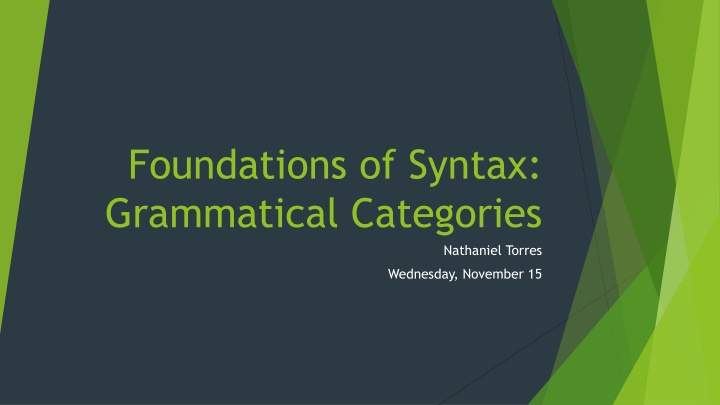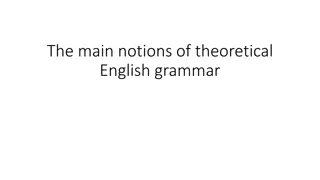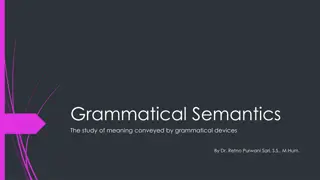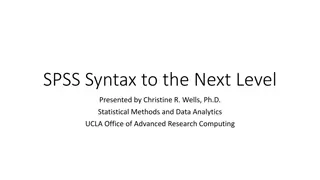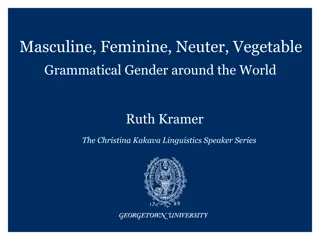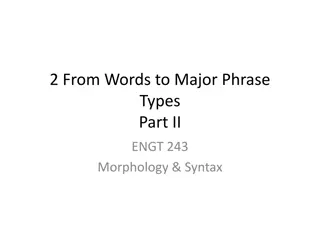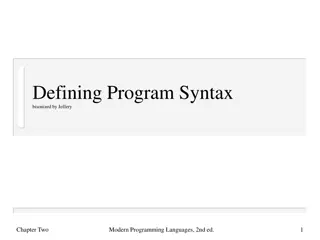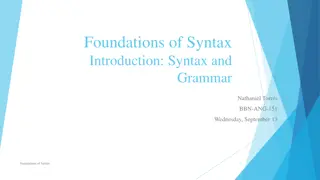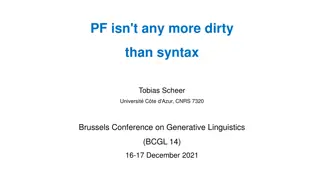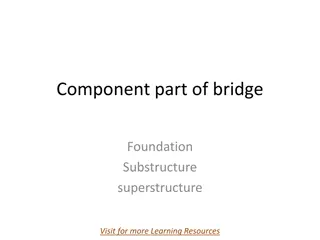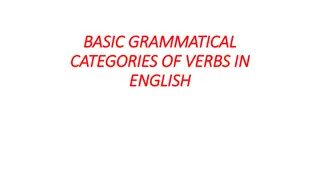Foundations of Syntax: Grammatical Categories
Grammatical categories define the different types of noun phrases found in a clause, focusing on the functions of phrases in sentences. Explore the concept of subjects in various languages, understanding word order implications, and instances like subject-auxiliary inversion in interrogatives. Enhance your knowledge of syntax and sentence structure with a comprehensive overview of grammatical categories.
Uploaded on Mar 08, 2025 | 0 Views
Download Presentation

Please find below an Image/Link to download the presentation.
The content on the website is provided AS IS for your information and personal use only. It may not be sold, licensed, or shared on other websites without obtaining consent from the author.If you encounter any issues during the download, it is possible that the publisher has removed the file from their server.
You are allowed to download the files provided on this website for personal or commercial use, subject to the condition that they are used lawfully. All files are the property of their respective owners.
The content on the website is provided AS IS for your information and personal use only. It may not be sold, licensed, or shared on other websites without obtaining consent from the author.
E N D
Presentation Transcript
Foundations of Syntax: Grammatical Categories Nathaniel Torres Wednesday, November 15
Categories This week, we will take it a bit easier than usual and discuss grammatical categories. This is a fancy phrase that basically entails talking about the different functions a phrase can perform in a sentence. We have touched upon this briefly when we discussed theta roles, as these grammatical categories are tied to some extent to theta role assignment. Grammatical categories essentially define the different kinds of NPs that you may encounter in a clause.
Categories The Subject Every language is able to express the doer of an action, that is, the person who does the action of the verb in the sentence. We briefly touched on this when we discussed theta roles, but we will look at the idea of a subject in a more accessible and broader manner in this lecture. Languages differ on the positions of their subjects, and sometimes how they are expressed morphologically. We ll look at a few now.
The Subject The typical word order for English is SVO Subject Verb Object This means that for English the subject of a sentence is found on the left periphery of the sentence (that is, the leftmost position, though not always). John kicked the ball. John in this case is the subject because he is the one doing the kicking. This case is a little bit easier because there is one logical conclusion one can make due to the fact it makes no sense that the ball could be doing the kicking. How about when we have to people? John kissed Mary. Who is the subject of this sentence?
The Subject cont. Right, John still is the subject as he is the one doing the kissing. In English, the rigid word order provides us information about who the subject and the object is. Are there ever cases where the word order in English shows a subject in a position that is NOT the first element in the sentence?
The Subject cont. Yes, there are a few instances in which the subject does not appear as the leftmost word in a sentence. The primary case in which this occurs is interrogatives, or, questions. This occurs either when a wh-word is present, or when a simple yes-no question is being used. Consider: What book did John read for his syntax class? Did John read a book for his syntax class? In these cases, a word called an auxiliary changes places with the subject. This is called subject-auxiliary inversion. In these cases, the subject will always come immediately after the auxiliary.
A Weird Case English demonstrates a rather interesting case with respect to the subject. In English, there are certain constructions that have a subject without a specific referent in mind. Consider the following examples: It is raining outside right now. It is possible that Mary might come to prom with me. Certain predicates (words or phrases that link a subject to everything else in a sentence) require the insertion of an it in the subject position. This it does not refer to anything or anyone in particular. It is inserted as a rule of English grammar that every sentence must have an overt subject. This it in English is referred to as a pleonastic pronoun.
The Cross-Linguistic Subject Obviously, not all languages are the same with respect to how subjects are expressed. Languages like English are called analytic languages because they rely on a very strict word order instead of inflections to provide necessary grammatical information like what the subject and the object are. These languages include ones like English, Chinese, Vietnamese, Swedish, Afrikaans, i.a. These languages are typically SVO, with some slight variations in word order used often to express things like focus or topic.
Cross-Linguistic Subjects If we take a look at a language like Mandarin Chinese, we see a rigid word order similar to English: t hu shu y di n Y ngw n. she can speak a bit English She can speak a little English. If you try to swap the order of the subject t , and put it anywhere else, the sentence becomes ungrammatical.
Cross-Linguistic Subjects Cont. The same can be seen in the Germanic languages Swedish and Afrikaans, which require their subjects to be clause-initial in statements: Du m ste se den h r filmen! you must see this here movie.the You have to see this movie! But not something like *M ste titta p du den h r filmen. Afrikaans: Ek dink ek s cooler as jy. I think I-am cooler than you I think I m cooler than you. But not something like *Dink ek cooler is as jy ek. So, to summarize, these languages require a fixed position for their subjects at the left edge of their sentences because they lack a robust morphological system, just like English.
Different Ways to Express the Subject There are two principle types of languages with respect to subjects (and objects, which we ll see in a moment): Nominative Accusative Ergative Absolutive Both kinds of language types have very robust morphological case systems. They differ principally in the manner that they express their subjects and objects. In general, nominative absolutive languages do not morphologically mark the subject (overtly), whereas ergative absolutive languages typically mark the subject morphologically, but not the object.
Subject Differentiation Typical examples of nominative accusative languages include languages like: Hungarian, Russian, Turkish, German, Greek, among a plethora of others. Typical examples of ergative absolutive languages include languages like: the many languages of the Caucuses (like Chechen, Laz, Georgian, Abkhaz, etc.), Basque, and many North American indigenous languages.
Subject Differentiation Cont. Again, nominative accusative languages do not typically show any kind of (overt) morphological form on the subject. These languages, because they have more robust morphological forms allow for flexible word orders, unlike what we saw for analytic languages. Mari megh vta a bar tokat a bulira. Mari.NOM invite.PST.3SG the friends.ACC the party.SUBL Mari invited (her) friends to the party. Jessi hott de Kuche in de Ofe Jessi.NOM has the.ACC cake.ACC in the.ACC oven.ACC Jessi stuck (put) the cake in(to) the oven. In both Hungarian and German, we can see that the subjects are being expressed without any kind of overt case morphology indicating that they are nominative. Let s compare this now with the alternative. gschteckt. (Swabian) stuck
Subject Differentiation Cont. The ergative absolutive situation is slightly different because these languages can occur with unmarked subjects, but the situations in which they occur are very specific. In general, the rule is this: If the subject appears with an intransitive verb, then it appears with no marking. If it appears with a transitive verb, then the ergative case suffix is attached. Recall that intransitive verbs are those that do not take an object, whereas transitive verbs take a direct object.
The Ergative Subject - Basque Let s take a look at Europe s only surviving pre-Indo-European language, Basque which is an ergative absolutive language. Basque is a language that is spoken in the north of Spain and Southern France, collectively known in Basque as the Euskal Herria. The subject of intransitive sentences in Basque are expressed like the subjects in nominative accusative languages, that is, with no overt morphological marking. noa. today I church.ALL go.NPST.1SG I am going to church today. Gaur ni elizara In a system like Basque, the case on the subject ni in the example, is actually absolutive, as there is no nominative case.
The Ergative Case The last example involved an intransitive verb (i.e., joan to go ). When a transitive verb is used, the subject must be inflected in the ergative case and receives an overt case morphology. Confer: Gaur nik txokolaterik jan nahi dut. today I.ERG chocolate.PART eat want AUX.NPST.1SG I want to eat some chocolate today. When a transitive verb is used the ergative case suffix k is used in order to express the subject of this verb. Thus, we can see that languages are capable of variation in expressing their subjects.
The Object Let s now go back to English and discuss the object. Recall that we said that English is an analytic SVO language. What this essentially means is that the first noun in a sentence is always the subject and the second noun is always the object. Let s consider the following clause: John ate the soup. John is, of course, the subject. Now we can identify the soup as the object as it is the second noun in the sentence. The object is the noun that is receiving the action of the main verb in the sentence.
The Object Cont. If we apply this same logic to a yes-no question we find that nothing has changed: Did John eat the soup? SUBJ OBJ For the time being, however, we will ignore wh-questions because an obvious problem arises: What did John eat? Where is the object if we said that the second noun is always the object in an English sentence? This involves a syntactic movement which we will not go into detail about, but rest assured there is indeed an object after the verb eat.
The Cross-Linguistic Object English, and other analytic languages lacking overt case morphology on the majority if not all of the nouns in the language do not provide information about object marking in other languages. Here, again, we can consider nominative absolutive languages versus ergative absolutive languages. We will consider the languages that we have already looked at.
The Nom Acc Object In nominative accusative languages, the object is overtly marked with a suffix called the accusative case. This suffix lets the listener know what noun is receiving the action of a transitive verb. Let us consider Hungarian, which has an overt accusative case in (V)t: Ki magyar zta el az gy-et? who.NOM explain.PST.3SG PARTICLE the issue-ACC Who explained (thoroughly) the issue? Az-t hiszem, hogy Mari megcsin lta a munk -t. that.ACC believe.NPST.1SG that Mari.NOM do.PST.3SG the work.ACC I think Mari did the work. We can see two things in the Hungarian examples: 1) the object of transitive verbs is being overtly marked through the morphology, and 2) because it is being marked overtly, Hungarian nouns are more flexible with respect to their position in the sentence. In contrast to English, then, Hungarian is more flexible in its word order because case marking makes it clear what the grammatical relations in the sentence are, in this case, what is receiving the action of the verb.
The Erg Abs Object If we now compare object marking with an ergative absolutive language, we see that it is the opposite paradigm. The subject is what is being overtly marked in transitive constructions, and the object is what is being left bare , that is, in the absolutive case. Let us take another Basque example.
The Erg Abs Object Cont. Consider the following transitive sentence from Basque: Atzo nik liburuak irakurri ditut. yesterday I.ERG book.ABS.PL read.PST.PTCP AUX.1SG I read the books yesterday. If you compare this with the Hungarian examples where the direct object of the verb was marked with an ending (V)t, Basque does not mark its objects at all. We can, however, see that the subject in this sentence ni I is marked with the ergative case suffix k which is not what we see in nominative accusative languages.
Exercises Identify the subjects and objects in the following sentences: John hit the baseball. Did Mary see the movie? John knows that Mary saw the movie. Does Mary know who went to the store on Saturday? John knows that Mary asked if Bill ate the last cookie in the cookie jar.
